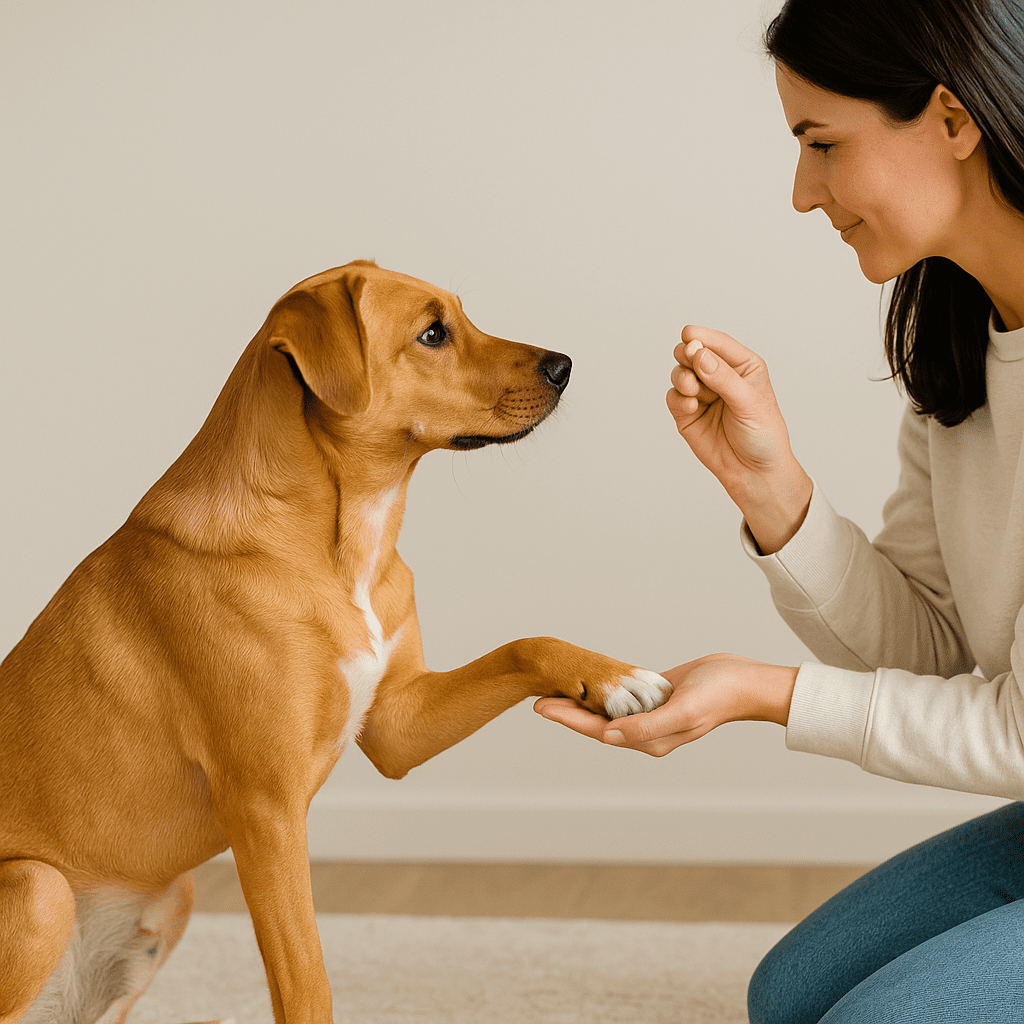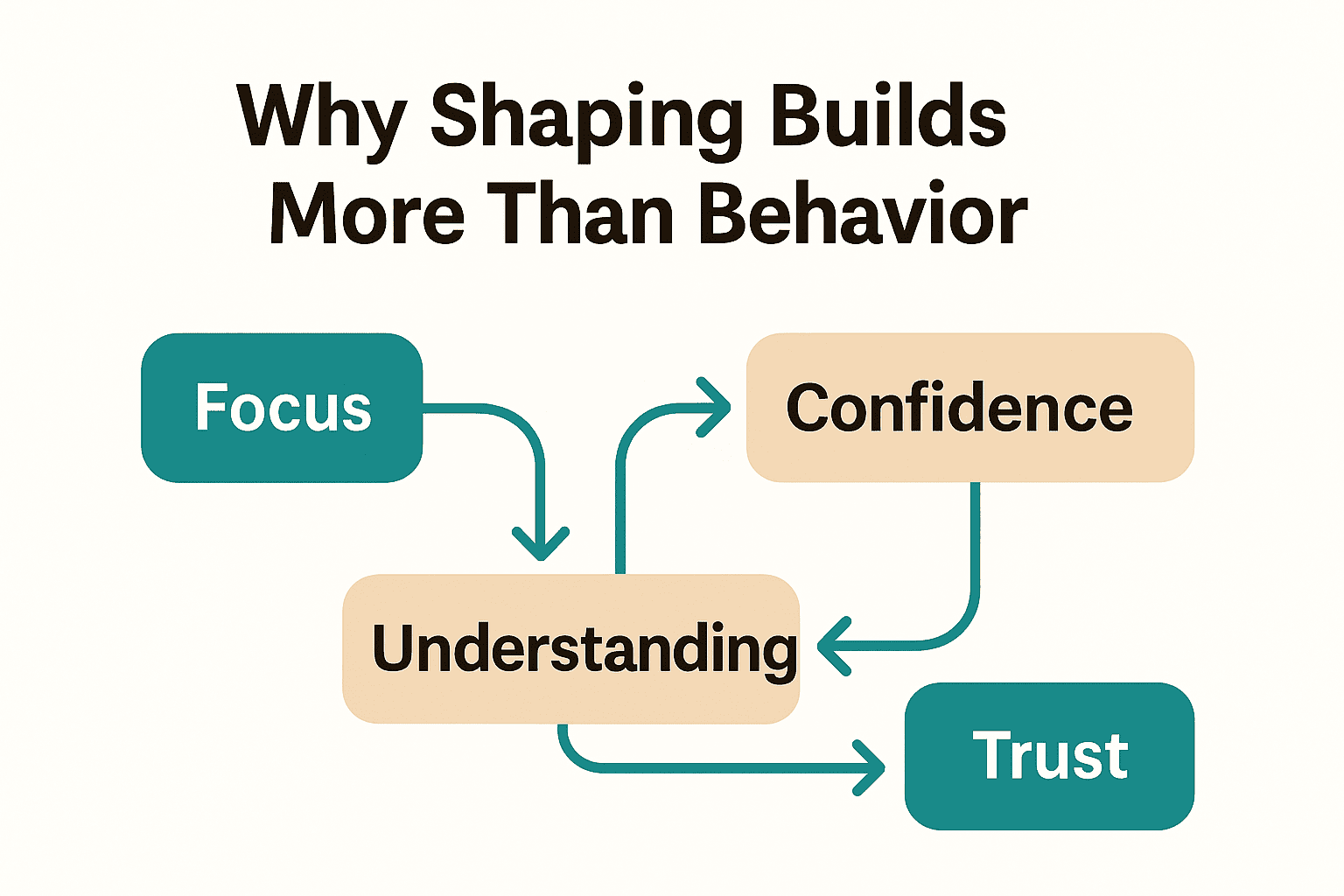
🔍 What Is Shaping in Dog Training?
Shaping in dog training is a powerful behavioral training technique based on rewarding incremental progress toward a desired behavior. It’s like teaching your dog in baby steps—one success at a time—until they master something amazing.
Instead of waiting for a dog to magically perform the full command, shaping in dog training builds it piece by piece. Whether you’re training a beginner pup or refining an advanced skill, this method taps into how dogs naturally learn—through cause and effect.
🎯 Why Use Shaping in Dog Training?
Most behaviors you want from your dog (like loose leash walking, settling on a mat, or ignoring distractions) are too complex to teach in one leap. That’s where shaping shines. It lets you:
- Break big behaviors into tiny wins
- Reinforce learning every step of the way
- Keep training positive, engaging, and clear
📌 Example: Want your dog to go to their bed when the doorbell rings? With shaping, you’d first reward looking at the bed, then stepping toward it, then placing a paw on it—until “go to bed” becomes second nature.
Shaping can also be used to develop a variety of useful or just-for-fun behaviors. From agility training to polite greetings, shaping builds precision and enthusiasm in dogs of all breeds and ages.
Another advantage? It keeps training sessions interesting and mentally stimulating, which can help prevent boredom and behavioral issues. Dogs that are encouraged to think and problem-solve are typically calmer and more adaptable.
🧬 How Shaping Works: The Psychology Behind It
Shaping in dog training is rooted in operant conditioning, a learning process where behaviors are strengthened or weakened by consequences. Every reward your dog receives for an action makes that action more likely to happen again.
It’s also linked to successive approximation—rewarding behavior that’s closer and closer to the goal. This is how wild animals are trained to perform complex tricks… and why it works wonders with your pup.
📄 Research Insight: Studies in animal behavior show that shaping enhances a dog’s cognitive flexibility, helping them adjust to changing criteria faster than dogs trained using only luring.
🚀 Bonus: Shaping builds problem-solving skills and confidence in your dog. They learn how to learn. This sense of accomplishment increases their willingness to try new behaviors and reduces hesitation.
🧪 Shaping vs. Luring vs. Capturing
Let’s break it down:
| Technique | How It Works | When to Use |
|---|---|---|
| Luring | Uses treats to guide a dog’s body | Best for simple behaviors like “sit” or “down” |
| Capturing | Rewards behaviors that happen naturally | Great for behaviors your dog already offers |
| Shaping | Rewards progressive steps toward goal | Ideal for complex behaviors or building focus |
Shaping in dog training requires more patience than the other two, but it leads to a deeper understanding of the desired behavior. It also avoids reliance on hand signals or food prompts, which can become crutches if not faded out.
🔗 See our full comparison of dog training methods →
🛠️ How to Use Shaping (Step-by-Step)
- Pick a clear end goal.
→ Example: Dog lies calmly on mat for 60 seconds. - Identify the first small step.
→ Maybe just looking at the mat. - Mark and reward that behavior.
Use a clicker or a consistent marker word like “yes!” - Wait for a slightly improved behavior.
→ Now reward a step toward the mat. - Continue rewarding closer approximations.
- Only raise the criteria when your dog is confidently repeating the current step.
🧠 Pro Tip: If your dog gets frustrated, go back to the last successful step. Shaping isn’t linear. Regression is part of the learning curve.

🧩 Why Shaping Builds More Than Behavior
Shaping strengthens your dog’s:
- Focus: They’re actively watching for cues.
- Confidence: Success builds momentum.
- Understanding: Clear feedback reduces stress.
It also builds your training skills. You’ll become more aware of timing, reinforcement schedules, and reading your dog’s signals.
Shaping encourages trainers to slow down, observe, and adapt. This creates a better bond and more resilient learning.
📉 Troubleshooting Common Shaping in Dog Training Mistakes
Mistake: Raising the bar too fast
Fix: Reward smaller steps. Watch for signs of confusion.
Mistake: Dog stops trying
Fix: Lower the criteria and get back on a success streak.
Mistake: Repeating same step too long
Fix: If your dog’s offering the same thing over and over, raise the criteria slightly.
Mistake: Relying on prompts or cues too soon
Fix: Let the dog figure it out. Avoid jumping in to “help.”
For a deeper dive into shaping and other positive training strategies, explore the Karen Pryor Clicker Training guide on shaping behavior. Learn from the pioneers of force-free training and get practical tools from science-backed behaviorists.
🗺 Real-Life Examples of Shaping
🚴 Loose Leash Walking
Start with one step next to you. Reward that. Add a second. Gradually increase the number of steps. Eventually, walking politely becomes the norm.
🛏 Crate Training
Reward your dog for sniffing the crate, then stepping inside, then settling. Don’t shut the door too early.
🧽 Trick Training
Teach a spin or bow by clicking for head turns, body shifts, then full movement.
👋 Greeting Visitors
Start by reinforcing calmness while someone stands nearby. Then as they approach. Then as they speak.
These examples highlight how versatile and effective shaping can be when done with intention.
🛃 Wrap-Up: Trust the Process
Shaping turns training into a fun, collaborative process. It’s less about commands and more about communication. Start with something simple. Celebrate small wins. And remember—every “yes!” builds a better bond.
It’s not just about obedience. It’s about understanding, trust, and growth.
📚 Want to Master All 5 Training Principles?
Each method builds on the others. Explore them all to truly understand how dogs learn — and how to train with clarity, confidence, and compassion.
🎁 Ready to test your skills?
Get the Free Quiz Pack
